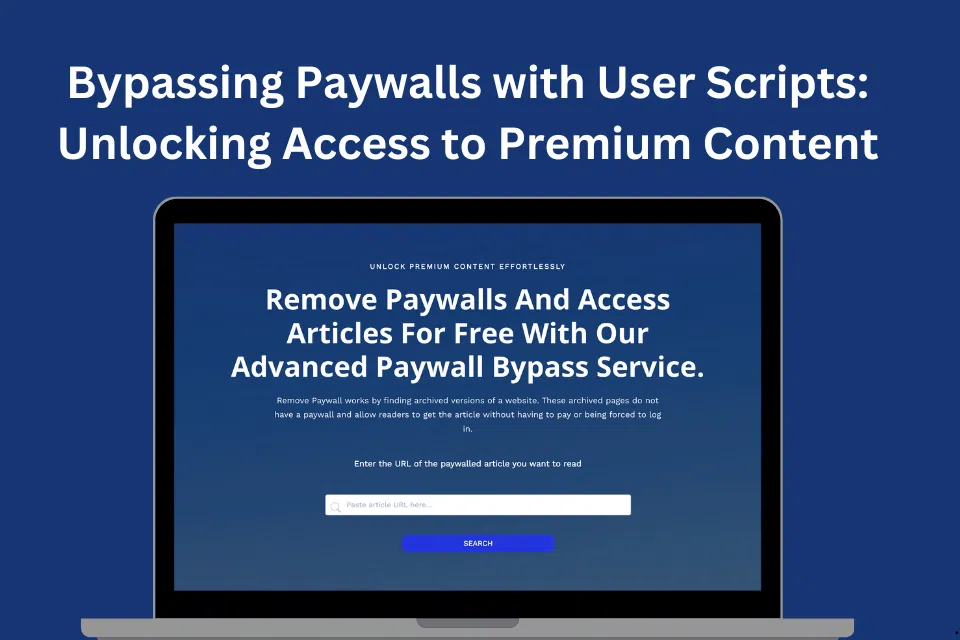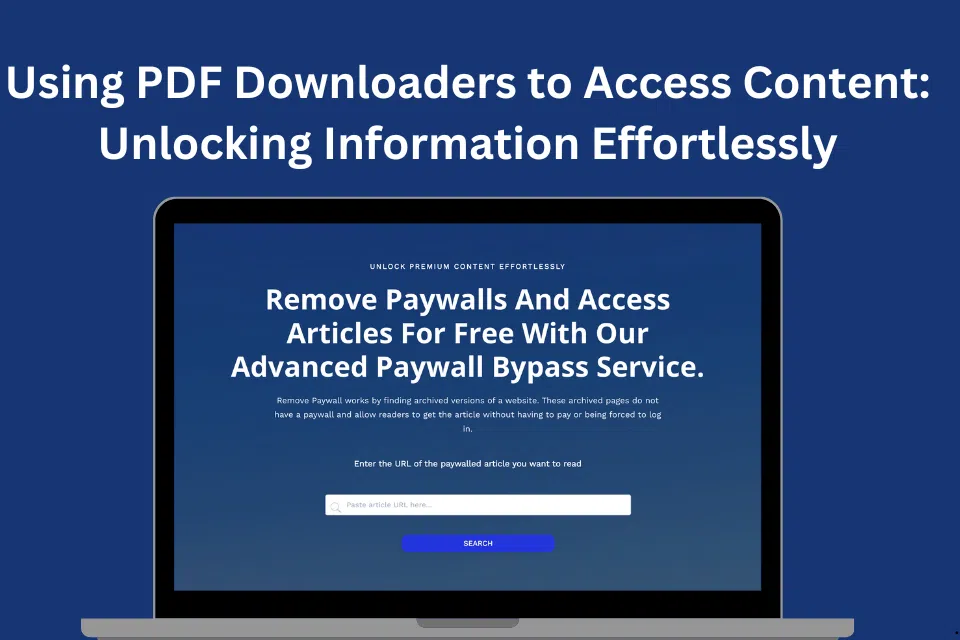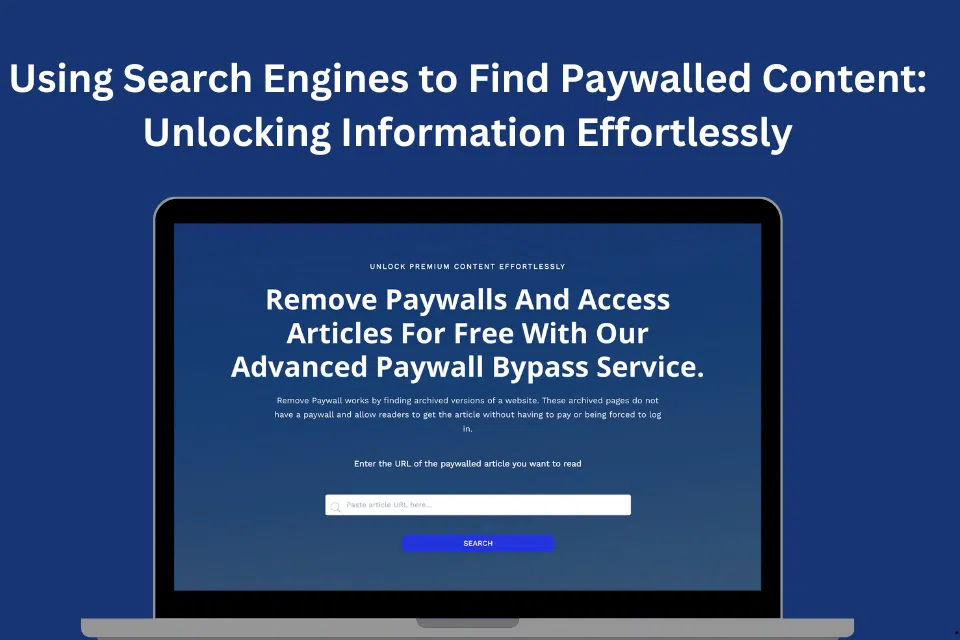Accessing Paywalls with User Scripts: Unlocking Access to Premium Content
In today’s digital world, access to information is often restricted by paywalls, limiting the availability of premium content to subscribers. For those seeking to bypass these barriers, user scripts offer an effective solution. This comprehensive guide explores how to use user scripts to bypass paywalls, how to install and manage these scripts, and the ethical considerations surrounding their use.
Understanding User Scripts
User scripts are small programs written in JavaScript that can be run in the browser to modify web pages on the fly. These scripts can automate tasks, customize the browsing experience, and, in this context, bypass paywalls. User scripts are typically managed through browser extensions like Tampermonkey or Greasemonkey, which allow users to install, execute, and manage scripts with ease.
How to Use User Scripts to Access Content
- Choosing the Right Browser Extension
The first step in using user scripts to bypass paywalls is selecting a suitable browser extension that supports user script management.
- Tampermonkey: Available for Chrome, Firefox, Safari, Microsoft Edge, and Opera. It is one of the most popular user script managers.
- Greasemonkey: Available for Firefox. It was the original user script manager and remains popular among Firefox users.
- Violentmonkey: Available for Chrome, Firefox, and other browsers. It is an open-source alternative to Tampermonkey and Greasemonkey.
- Installing the Browser Extension
Once you have chosen a user script manager, the next step is to install it in your browser.
- Tampermonkey Installation:
- Chrome: Visit the Chrome Web Store, search for Tampermonkey, and click “Add to Chrome.”
- Firefox: Visit the Firefox Add-ons site, search for Tampermonkey, and click “Add to Firefox.”
- Greasemonkey Installation:
- Firefox: Visit the Firefox Add-ons site, search for Greasemonkey, and click “Add to Firefox.”
- Violentmonkey Installation:
- Chrome: Visit the Chrome Web Store, search for Violentmonkey, and click “Add to Chrome.”
- Firefox: Visit the Firefox Add-ons site, search for Violentmonkey, and click “Add to Firefox.”
- Finding User Scripts to Bypass Paywalls
Several repositories and websites host user scripts designed to bypass paywalls. Some popular sources include Greasy Fork, OpenUserJS, and GitHub.
- Greasy Fork: A popular repository for user scripts, including many designed to bypass paywalls.
- OpenUserJS: Another repository hosting a variety of user scripts.
- GitHub: Many developers host their user scripts on GitHub, where you can find and download them.
- Installing a User Script
After finding a suitable user script to bypass a paywall, you need to install it in your browser.
- Locate the Script: Browse the repositories and find a user script that suits your needs. For example, search for “bypass paywall” on Greasy Fork.
- Install the Script: Click on the user script you want to install. If you are using Tampermonkey or Greasemonkey, a prompt will appear asking if you want to install the script. Click “Install” to add the script to your browser.
- Configuring and Managing User Scripts
Once installed, you may need to configure and manage your user scripts to ensure they work correctly.
- Access the User Script Manager: Click on the Tampermonkey or Greasemonkey icon in your browser toolbar to open the script manager.
- Enable or Disable Scripts: You can enable or disable individual scripts as needed. This can be useful if a script interferes with other websites or if you only need it temporarily.
- Update Scripts: User scripts may receive updates from their developers. Check for updates regularly to ensure your scripts are up to date and functioning properly.
How to Install and Manage Access Content Scripts
- Step-by-Step Installation Guide
- Tampermonkey:
- Visit Greasy Fork: Go to Greasy Fork.
- Search for Scripts: Use keywords like “bypass paywall” to find relevant scripts.
- Install the Script: Click on the script, then click “Install this script” to add it to Tampermonkey.
- Greasemonkey:
- Visit OpenUserJS: Go to OpenUserJS.
- Search for Scripts: Look for scripts designed to bypass paywalls.
- Install the Script: Click on the script, then click “Install” to add it to Greasemonkey.
- Tampermonkey:
- Configuring Scripts for Specific Websites
User scripts can often be customized to work on specific websites. This can involve editing the script to target the desired site.
- Edit Script Settings: Open the user script manager, select the script you want to edit, and modify the settings to include the URLs of the websites you want to bypass.
- Include or Exclude Sites: You can specify which sites the script should run on by editing the @include and @exclude fields in the script’s metadata.
- Troubleshooting and Maintenance
Sometimes, user scripts may not work as expected. Troubleshooting and regular maintenance can help ensure smooth operation.
- Check for Conflicts: Ensure that multiple scripts are not conflicting with each other. Disable other scripts that might interfere with the paywall bypass script.
- Update Regularly: Keep your user scripts and browser extensions updated to avoid compatibility issues and to benefit from the latest improvements and bug fixes.
- Read User Feedback: Check user reviews and feedback on the script’s page to see if others have encountered similar issues and found solutions.
Ethical Considerations and Legal Implications
While user scripts can effectively bypass paywalls, it’s important to consider the ethical and legal implications of using them.
- Respecting Content Creators
Content creators and platforms rely on subscriptions and paywalls to generate revenue. Bypassing these paywalls can deprive them of financial support.
- Consider Subscribing: If you regularly access content from a particular site, consider subscribing to support the creators and ensure the sustainability of their work.
- Legal Considerations
Using user scripts to bypass paywalls can have legal implications, depending on the terms of service of the website and local laws.
- Review Terms of Service: Check the website’s terms of service to understand their policy on using scripts to access content.
- Understand Local Laws: Be aware of the legal landscape in your region regarding the use of user scripts to bypass paywalls.
Advanced Tips for Using User Scripts
To enhance your experience and ensure the most effective use of user scripts, consider these advanced tips:
- Creating Custom User Scripts
If you have coding skills, you can create custom user scripts tailored to your specific needs.
- Learn JavaScript: Understanding JavaScript is essential for writing user scripts. Many online resources and tutorials can help you get started.
- Use Script Templates: Start with existing script templates from repositories like Greasy Fork or OpenUserJS and modify them to suit your requirements.
- Combining Scripts with Other Tools
Integrate user scripts with other tools to enhance your access to content.
- Combine with VPNs: Use a VPN to bypass geographical restrictions, and user scripts to bypass paywalls. Learn more in our guide on Using VPNs to Bypass Paywalls.
- Use with PDF Downloaders: Save paywalled content as PDFs for offline reading. Check out our article on Using PDF Downloaders to Access Content.
- Enhancing Script Security
Ensure that the user scripts you use are safe and secure.
- Review Script Code: Before installing a script, review its code to ensure it doesn’t contain malicious elements. Reputable repositories often have community reviews that can help with this.
- Regular Updates: Keep your scripts updated to protect against security vulnerabilities and to ensure compatibility with website changes.
Real-Life Examples and Case Studies
To illustrate the effectiveness of using user scripts to bypass paywalls, here are some real-life examples and case studies:
- Academic Research
Researchers often encounter paywalled academic articles. By using user scripts, they can access these articles for free and save them for offline reading.
- Case Study: A researcher uses a combination of Google Scholar and a user script from Greasy Fork to access paywalled academic papers. This method allows them to compile a comprehensive library of resources without paying for individual articles.
- Journalism and Reporting
Journalists and reporters frequently need access to paywalled news articles for their work. User scripts enable them to bypass these paywalls and access the necessary information.
- Example: A journalist uses a user script to bypass paywalls on major news websites. This allows them to gather information quickly and efficiently, ensuring accurate and timely reporting.
- Personal Use and Knowledge
Individuals seeking to expand their knowledge or stay informed on specific topics can use user scripts to access paywalled content.
- Scenario: A history enthusiast uses archival tools and user scripts to access historical documents and articles. By combining these methods, they can build a personal digital library for offline reading.
Related Articles and Tools
To further explore methods and tools for bypassing paywalls and accessing content, check out the following resources:
- Learn how to use PDF downloaders in Using PDF Downloaders to Access Content.
- Discover temporary bypass methods in Temporary Bypassing Techniques.
- Explore browser extensions that can help in Using Browser Extensions to Bypass Paywalls.
Conclusion
User scripts offer a practical and effective solution for bypassing paywalls and accessing restricted content. By leveraging user script managers like Tampermonkey and Greasemonkey, you can install, configure, and manage scripts that unlock a vast array of digital content. However, it’s essential to use these tools responsibly, considering the ethical and legal implications of bypassing paywalls.
For more comprehensive strategies and tools to bypass paywalls and access restricted content, explore our detailed guide on Effective Strategies to Access Restricted Content. By staying informed and considering ethical implications, you can enjoy a wide range of digital content responsibly and legally.





